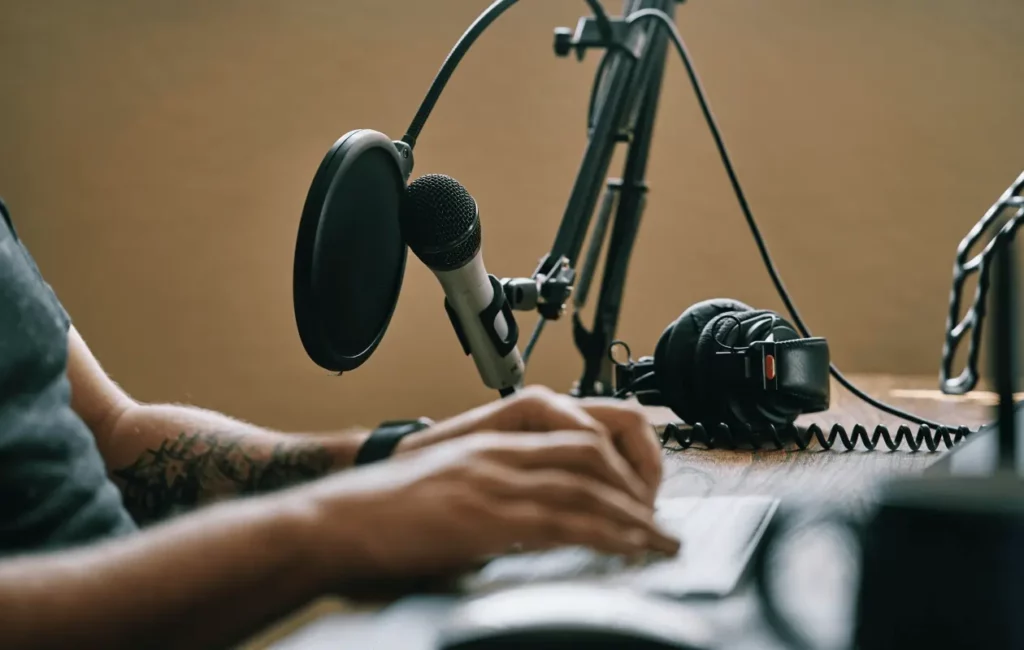When it comes to creating a successful podcast, recording high-quality audio for your podcast is essential. Good audio keeps listeners engaged and helps you establish a professional image. In this article, we’ll share practical tips on how to achieve top-notch audio quality for your episodes. Whether you’re a beginner or have some experience, these tips will guide you in creating clear and crisp sound.
1. Invest in Quality Equipment
The first step to recording high-quality audio for your podcast is to invest in the right equipment. A good microphone is crucial. USB microphones are great for beginners due to their ease of use, while XLR microphones offer higher quality but require an audio interface. Additionally, consider using headphones to monitor your audio during recording. This equipment will greatly enhance the sound quality of your podcast.

2. Choose the Right Recording Environment
Your recording environment plays a significant role in the audio quality. Look for a quiet space where you can minimize background noise. If possible, choose a room with soft furnishings like carpets, curtains, and cushions. These materials absorb sound and reduce echo. If you’re in a noisy area, consider using soundproofing materials or recording at times when it’s quieter.
3. Use Proper Microphone Technique
When recording high-quality audio for your podcast, how you position your microphone matters. Keep the microphone about six inches away from your mouth for optimal sound. Make sure to speak directly into the microphone to avoid distortion. Additionally, use a pop filter to reduce plosive sounds from your speech. This simple tool can make a big difference in clarity.
4. Record at the Right Levels
Setting the correct recording levels is vital. Aim for a peak level between -12 dB and -6 dB when recording. This range prevents distortion while ensuring a strong signal. If the levels are too low, you may introduce noise during post-production. Monitor your levels in real time and adjust as needed to maintain consistency throughout the recording.
5. Use Recording Software Effectively
Choosing the right recording software is another key element in recording high-quality audio for your podcast. Programs like Audacity, GarageBand, or Adobe Audition provide various features to enhance your audio. Familiarize yourself with the software and use its tools to edit your recordings, remove background noise, and apply effects. This will help you create polished final products.
6. Plan Your Content
Having a clear plan for your podcast content can improve audio quality. A well-structured script or outline helps you stay on topic and reduces the chances of filler words and pauses. This clarity leads to a smoother listening experience. Prepare key points in advance, and practice your delivery to ensure confidence during recording.
7. Consider Using Remote Recording Tools
If you’re interviewing guests remotely, using reliable remote recording tools can enhance audio quality. Platforms like Riverside.fm or Zencastr allow you to record high-quality audio directly from your guests’ devices. This method ensures that you capture the best sound without interruptions from internet issues. Test the software before your recording to ensure everything works smoothly.
8. Edit with Care
Editing is an essential part of recording high-quality audio for your podcast. After recording, spend time refining your audio. Remove long pauses, filler words, and any mistakes. Adjust the volume levels to ensure consistency. You can also add music or sound effects, but use them sparingly to avoid overwhelming your main content.
9. Export in the Right Format
When you finish editing your podcast, exporting it in the right format is crucial. Most podcasters choose MP3 for its balance of quality and file size. Aim for a bitrate of 128 kbps or higher for good quality. Ensure your episode is compatible with podcast platforms by following their guidelines for file size and format.
10. Get Feedback and Improve
Finally, seek feedback from listeners. Ask for their opinions on audio quality and any areas for improvement. Regularly listening to your own recordings can also help you identify issues and track your progress. As you continue recording high-quality audio for your podcast, you’ll develop your skills and create even better episodes.
Conclusion
In conclusion, recording high-quality audio for your podcast is essential for engaging your audience and establishing a professional presence. By investing in quality equipment, choosing the right environment, and mastering editing techniques, you can significantly improve your podcast’s sound. Remember, practice makes perfect. Keep experimenting and refining your process to achieve the best audio quality possible.











